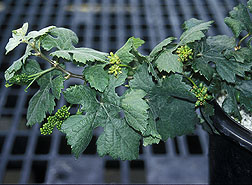This page has been archived and is being provided for reference purposes only. The page is no longer being updated, and therefore, links on the page may be invalid.
|
|
New Dwarf Type May Be a Giant of Grape Research
By Luis PonsDecember 21, 2006
Really big things may come from Pixie, a very small grape recently released by the Agricultural Research Service (ARS).
The seeded black fruit of this grape line is not meant for eating. Instead, the variety's novel traits make it ideal for genetics, genomics, breeding and other research that can lead to new breeding lines or cultivars that grape consumers will love.
Pixie fits well into its classification as a dwarf variety. According to Peter Cousins—the geneticist in the ARS Grape Genetics Research Unit at Geneva, N.Y., who helped develop it—mature clusters of Pixie typically measure slightly less than four inches long. He said that a Pixie grapevine can be grown in a coffee cup and still produce some grapes.
This characteristic reduces by about 50-fold the amount of space needed for grapevine experimentation, as Pixie vines can be grown in the greenhouse to maturity without ever needing to be planted in a vineyard.
But what really makes the new grape line special is its ability to initiate fruit year round. In fact, according to Cousins, it's typical to observe flower buds, blooms, immature fruit, and ripe fruit—all on the same vine.
While this trait would not be useful for the consumer-grape industry—grape producers prefer to pick their crop just once—it does accelerate research, allowing for year-round studies on flowers and berries at all stages of development.
Cousins and University of California-Davis scientist David Tricoli developed Pixie by regenerating whole plants from embryogenic cells of the Pinot Meunier variety of grapes.
The concept of developing such dwarf grape plants was first demonstrated and published by Australian scientists Paul K. Boss, Mark R. Thomas, K.G. M. Skene and Martin Barlass.
Intellectual property protection will not be sought for Pixie, according to Cousins.
To inquire about the availability of this new variety, write to Peter Cousins, USDA-ARS, Grape Genetics Research Unit, 630 W. North St., Geneva, NY 14456.
ARS is U.S. Department of Agriculture's chief scientific research agency.


 The Pixie dwarf variety grapevine shown above is slightly less than 10 inches in length. The grapes measure just a shade less than four-tenths of an inch in diameter. Photos courtesy
The Pixie dwarf variety grapevine shown above is slightly less than 10 inches in length. The grapes measure just a shade less than four-tenths of an inch in diameter. Photos courtesy